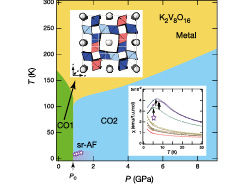Metal-Insulator Transition and Charge Order under Pressure in Vanadium Hollandite
Y. Ueda Group
Metal-insulator transition (MIT) is one of the most drastic phenomena in strongly correlated electron systems. The most remarkable property of binary vanadium oxides is MIT as a function of temperature. The MITs in mixed valent binary vanadium oxides are characterized by charge order and formation of spin singlet V4+-V4+ pairs. We found a MIT at 170 K in a ternary vanadium oxide; hollandite K2V8O16. This MIT is accompanied by a sudden jump of resistivity and reduction of magnetic susceptibility [1]. The structure changes from a tetragonal structure for the high-temperature (HT) metallic phase to a monoclinic structure for the low-temperature (LT) insulating phase. The unit cell of LT phase becomes as large as √2× √2 × 2, suggesting charge order and formation of V-V pairs. Recently we succeeded in determining crystal structure of LT phase [2]. The structure of K2V8O16 consists of a tubular V8O16 framework and K ions (see the inset in Fig. 1). The V8O16 framework is built up by bridging double chains (zigzag chains) made of edge-sharing VO6 octahedra via oxygen atoms. The V site is unique in HT phase. Hence, the compound has a uniform and average valence of V+3.75 (V3+/V4+ = 1/3). In LT phase (CO1), on the other hand, charge segregation and order yield two types of double chains; V4+-V4+ double chain and V3+-V4+ double chain. These double chains are arranged in a manner shown in the upper inset in Fig. 1, resulting in an inplane supercell of √2× √2 . Furthermore, half of the double chains are dimerized by forming V3+-V3+ pairs in the V3+-V4+ double chains and V4+-V4+ pairs in the V4+-V4+ double chains, resulting in the doubling of the b-axis (tunnel direction). These V pairs perfectly explain the reduction of magnetic susceptibility due to the formation of spin singlets. The remained unpaired V4+ chains, which would have a much larger intra-chain antiferromagnetic exchange interaction than 170 K, are responsible for the considerable and temperature-independent magnetic susceptibility in LT phase.

Fig. 1. P-T phase diagram of K2V8O16. K2V8O16 shows a metal-insulator transition at 170 K under ambient pressure, accompanied by charge order and formation of spin singlet V4+-V4+ pairs. The charge ordered manner of this insulating phase (CO1) is shown in the upper inset. The V8O16 framework consists of two types of double chains: one is formed by V3+O6 chain (red) and V4+O6 chain (deep blue) and the other is formed by only V4+O6 chains (deep blue and sky blue). V3+-V3+ pairs and V4+-V4+ pairs are formed along the b-axis in V3+O6 chain (red) and V4+O6 chain (sky blue), respectively, resulting in the dimerization along the b-axis. The transition temperature is once suppressed by pressure and then turns to increase beyond the critical pressure Pc ~ 1 GPa. This means the appearance of a new insulator phase (CO2) above Pc. The lower inset shows magnetic susceptibility curves under various pressures. They suddenly change beyond Pc; they are almost temperature independent below Pc, while above Pc they have maximums around 7 K, indicating the development of short range antiferromagnetic order (sr-AF).
The MIT in K2V8O16 is accompanied by a volume increase in LT phase. Actually the MIT is suppressed by hydrostatic pressure, but unexpectedly the transition temperature turns to increase beyond the critical pressure Pc ~ 1 GPa [3], as shown in Fig. 1. This indicates the emergence of new charge ordered phase (CO2) beyond Pc. The magnetic susceptibility clearly shows the appearance of a new phase with a different electronic state. As shown in the lower inset in Fig.1, the magnetic susceptibilities are almost temperature independent below Pc, while above Pc the magnetic susceptibility curves have maximums around 7 K. The lack of long range magnetic order was confirmed from NMR. Hence, such maximums correspond to the development of short range order in one-dimensional magnetic chains. K2V8O16 has a formal valence of 6V4+ and 2V3+ and has 10 d electrons in an f.u. The Curie constants estimated from Curie-Weiss fitting of magnetic susceptibility correspond to 2 d electrons in an f.u. above Pc, assuming spin-1/2. This suggests that magnetic V ions in a fraction about 1/5 are arranged in a low dimensional manner and are weakly coupled. The manner of charge ordering and pairing has remained unsolved.
References
- [1] M. Isobe, S. Koishi, N. Kouno, J. Yamaura, T. Yamauchi, H. Ueda, H. Gotou, T. Yagi, and Y. Ueda, J. Phys. Soc. Jpn. 75, 073801 (2006).
- [2] A. C. Komarek, M. Isobe, J. Hemberger, D. Meier, T. Lorenz, D. Trots, A. Cervellino, M. T. Fernández-Díaz, Y. Ueda, and M. Braden, Phys. Rev. Lett. 107, 027201 (2011).
- [3] T. Yamauchi, H. Ueda, M. Isobe, and Y. Ueda, Phys. Rev. B 84, 115104 (2011).
